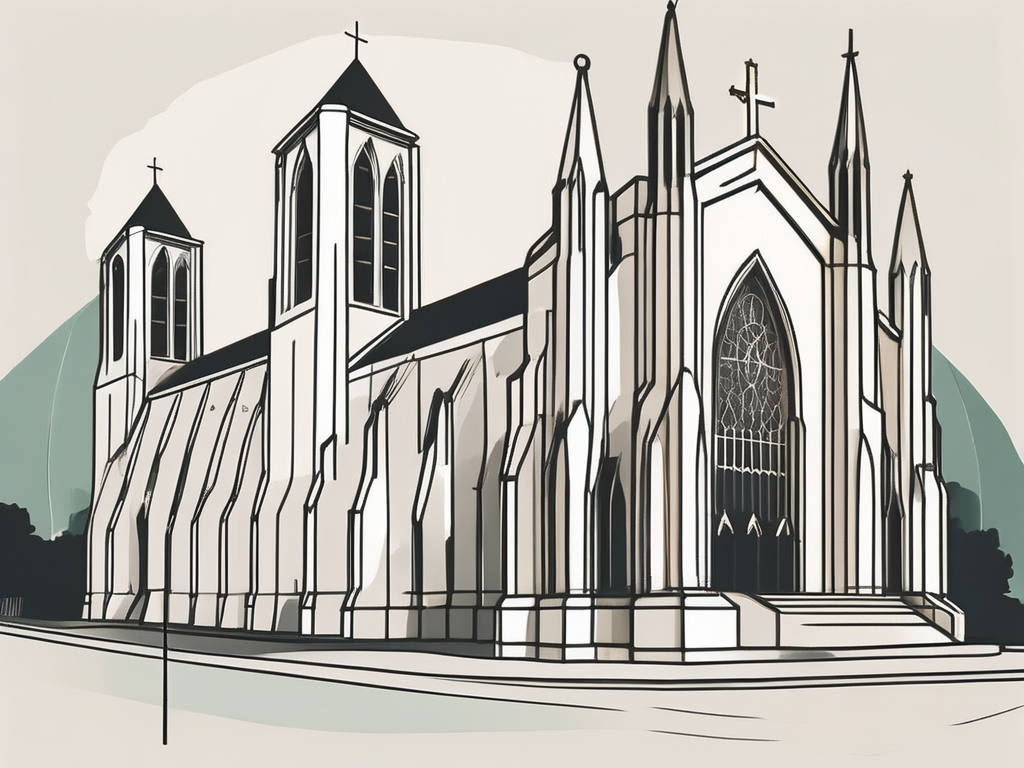Lutheran vs Protestant: Understanding the Key Differences
Historical Background of Lutheranism and Protestantism
In order to truly understand the key differences between Lutheran and Protestant beliefs, it is important to delve into their historical background. Both Lutheranism and Protestantism emerged during the time of the Reformation in the 16th century, a period marked by intense religious upheaval.
Origin of Lutheranism
Lutheranism traces its roots back to a German theologian named Martin Luther. Luther, in his quest for reform within the Roman Catholic Church, presented his famous Ninety-Five Theses in 1517. This document questioned the church’s teachings and practices, sparking a movement that would later become known as Lutheranism.
However, the origins of Lutheranism can be traced back even further. The seeds of discontent with the Roman Catholic Church were sown long before Luther’s time. Throughout the Middle Ages, there were various individuals and groups who voiced their concerns about the corruption and abuses within the church. These dissenting voices laid the groundwork for Luther’s eventual break with the Catholic Church.
Once Luther’s ideas gained traction, they spread like wildfire throughout Germany and beyond. The printing press, a relatively new invention at the time, played a crucial role in disseminating Luther’s writings and ideas. People eagerly read and discussed Luther’s works, leading to a widespread movement for religious reform.
Emergence of Protestantism
While Lutheranism formed the foundation of the Protestant movement, it soon branched out into different denominations. Protestantism as a whole encompasses a wide range of Christian beliefs that dissent from Roman Catholicism. It includes denominations such as Baptist, Methodist, Presbyterian, and many others, each with its own distinct characteristics and teachings.
The emergence of Protestantism was not a singular event but rather a complex and multifaceted process. As Luther’s ideas spread, other reformers emerged, each with their own unique perspectives and interpretations of Scripture. John Calvin, for example, played a significant role in shaping Reformed theology, which became the basis for Presbyterianism and other Calvinist denominations.
Protestantism also found fertile ground in other parts of Europe. In Switzerland, Ulrich Zwingli led a reform movement that diverged from Lutheranism in certain theological aspects. His teachings laid the foundation for the Swiss Reformed tradition, which includes denominations like the Swiss Reformed Church and the Dutch Reformed Church.
Across the English Channel, the English Reformation took place under the leadership of King Henry VIII and subsequent monarchs. This led to the establishment of the Church of England, which became a distinct branch of Protestantism known as Anglicanism.
As Protestantism continued to evolve and spread, it faced opposition from the Catholic Church and experienced internal divisions. The Counter-Reformation, initiated by the Catholic Church in response to the Protestant movement, sought to address some of the concerns raised by reformers while reaffirming Catholic doctrine.
Throughout the centuries, Protestantism has continued to diversify and adapt to different cultural and social contexts. Today, there are countless Protestant denominations worldwide, each with its own rich history and theological distinctives.
Core Beliefs and Teachings
When it comes to core beliefs and teachings, both Lutheranism and Protestantism share some common ground, but also exhibit notable differences.
However, delving deeper into the fundamental beliefs and central teachings of Lutheranism and Protestantism reveals a rich tapestry of theological nuances and historical context.
Fundamental Beliefs of Lutheranism
Lutheranism champions the belief in salvation by grace through faith alone. This core tenet, often referred to as “sola fide,” emphasizes that human beings cannot earn their way into heaven through good works or deeds. Instead, Lutherans believe that salvation is a gift from God, bestowed upon individuals who place their faith and trust in Him.
Furthermore, Lutherans place a strong emphasis on the authority and importance of the Bible as the ultimate source of truth. They believe that the Scriptures are divinely inspired and contain all that is necessary for faith and practice. Lutherans hold the Bible in high regard, considering it the infallible Word of God, providing guidance and wisdom for every aspect of life.
In addition to these core beliefs, Lutheranism also places great importance on the sacraments. Lutherans recognize two sacraments: baptism and the Lord’s Supper (also known as Holy Communion or the Eucharist). These sacraments are seen as visible signs of God’s grace and are considered essential for the spiritual growth and nourishment of believers.
Central Teachings of Protestantism
Protestantism, as a whole, believes in the doctrine of justification by faith alone, a principle that was popularized by Martin Luther during the Reformation. Like Lutherans, Protestants reject the notion that salvation can be earned through human effort. Instead, they emphasize that salvation is a free gift from God, received by faith alone.
Protestants also prioritize the Bible as the primary authority for faith and practice. They believe that the Scriptures are inspired by God and provide the ultimate guide for understanding and living out one’s faith. However, within Protestantism, there is a wide range of interpretations and approaches to biblical interpretation, leading to diverse theological perspectives and denominational traditions.
Furthermore, Protestantism encompasses a broad spectrum of beliefs and practices, with various denominations emphasizing different aspects of Christian theology. Some Protestant traditions place a strong emphasis on personal piety and individual relationship with God, while others focus on social justice and community engagement.
Moreover, Protestantism has been shaped by historical events and cultural contexts. The Reformation, which gave birth to Protestantism, was a movement that sought to reform the Catholic Church in the 16th century. This historical backdrop has influenced the development of Protestant beliefs and practices, as well as the relationship between Protestantism and other Christian traditions.
In conclusion, while Lutheranism and Protestantism share common beliefs such as salvation by grace through faith alone and the authority of the Bible, they also exhibit distinct characteristics and historical influences. Understanding the intricacies of these core beliefs and teachings provides a deeper appreciation for the rich diversity within the Protestant tradition.
The Role of Scripture
The interpretation and role of Scripture is another important aspect that sets Lutheran and Protestant beliefs apart.
Scripture, in both Lutheran and Protestant traditions, holds a central position of authority and significance. It is viewed as the inspired Word of God, containing divine revelation and guidance for believers. However, the approach to interpreting and understanding Scripture may differ among these traditions.
Scripture Interpretation in Lutheranism
In Lutheranism, Scripture interpretation is approached through the concept of “sola scriptura,” meaning “Scripture alone.” Lutherans believe that the Bible is the sole source of divine revelation and that it should be interpreted in light of the individual’s relationship with God. This emphasis on personal interpretation is rooted in Martin Luther’s belief that every Christian has direct access to God through faith.
Lutheran pastors play a crucial role in studying and teaching Scripture, providing guidance and insights to their congregations. However, Lutherans also encourage individuals to read and interpret the Bible for themselves. This belief in the priesthood of all believers empowers each person to engage with Scripture and develop a personal understanding of God’s message.
Through this individual exploration of Scripture, Lutherans seek to deepen their relationship with God and grow in faith. They believe that the Holy Spirit guides believers in their interpretation, illuminating the meaning of the text and its relevance to their lives.
Protestant View on Scripture
Protestants, similar to Lutherans, also uphold the principle of “sola scriptura.” They believe that Scripture is the ultimate authority and should be the primary source of guidance for faith and practice. However, different Protestant denominations may have varying approaches to interpreting Scripture.
Some Protestant traditions place a greater emphasis on personal interpretation, encouraging individuals to engage with the Bible and seek understanding through prayer and reflection. They believe that the Holy Spirit works through the individual believer, guiding them in their interpretation and application of Scripture.
On the other hand, certain Protestant denominations prioritize the guidance of church leaders or tradition in interpreting Scripture. They believe that the collective wisdom and teachings of the church community provide valuable insights into the meaning of the Bible. These traditions may place more emphasis on the role of pastors, theologians, and historical interpretations in understanding Scripture.
This diversity in scriptural interpretation contributes to the vibrant tapestry of Protestantism. It allows for a range of perspectives and insights, fostering intellectual and spiritual growth within the faith community. While there may be differences in interpretation, the shared commitment to the authority of Scripture unites Protestants in their devotion to God and His Word.
Worship Practices and Rituals
Worship practices and rituals are an integral part of religious traditions, providing a structured and meaningful way for believers to connect with the divine. While both Lutheran and Protestant churches engage in worship practices and rituals, their approaches may differ, reflecting the diversity within the broader Christian tradition.
Lutheran Worship Style
Lutheran worship services often follow a liturgical structure, rooted in the rich history of the church. These services incorporate traditional hymns, prayers, and sacraments such as baptism and communion. The liturgical structure provides a sense of continuity and unity, allowing worshippers to connect with the ancient traditions of the faith.
One distinctive feature of Lutheran worship is the emphasis on communal participation. The congregation actively engages in the various components of the service, responding to prayers, singing hymns together, and partaking in the sacraments. This participatory nature of Lutheran worship fosters a sense of community and shared faith.
Furthermore, Lutheran worship often includes the use of liturgical vestments, such as robes and stoles, worn by clergy and other participants. These vestments symbolize the sacredness of the worship space and the role of the clergy as intermediaries between the congregation and the divine.
Protestant Worship Practices
Protestant worship practices, on the other hand, exhibit a wide range of diversity across denominations. The Protestant movement, which emerged during the Reformation in the 16th century, emphasized the importance of individual faith and direct access to God.
As a result, some Protestant churches have adopted a more contemporary style of worship, seeking to connect with the younger generations. These services may employ modern music, multimedia displays, and less formal rituals. The aim is to create a vibrant and engaging worship experience that resonates with the contemporary culture.
However, it is important to note that not all Protestant churches have embraced this contemporary approach. Many maintain a more traditional worship style, similar to the Lutheran liturgical tradition. These churches may still incorporate hymns, prayers, and sacraments, but with their own unique interpretations and practices.
The diversity of worship practices within Protestantism reflects the flexibility and adaptability of the movement. It allows each congregation to express their faith in a way that is meaningful and relevant to their specific context.
Regardless of the style or form of worship, both Lutheran and Protestant churches share the common goal of creating a sacred space where believers can encounter the divine, express their devotion, and find spiritual nourishment. The worship practices and rituals serve as a bridge between the earthly and the divine, fostering a deeper connection with God and the community of believers.
Church Structure and Leadership
The organizational structure and leadership of Lutheran and Protestant churches also exhibit differences.
When examining the structure and leadership of Lutheran and Protestant churches, it is important to note that Lutheranism typically adheres to a hierarchical structure within the church. This means that local congregations are connected to regional bodies, which are in turn connected to national or international bodies. Each level of the hierarchy has its own set of leaders and governance structures, with the ultimate authority resting in the highest levels of the church.
Within this hierarchical structure, there are various leadership positions that play a crucial role in the functioning of the church. At the local level, there is typically a pastor who serves as the spiritual leader of the congregation. The pastor is responsible for preaching, teaching, and providing pastoral care to the members of the church. In addition to the pastor, there may also be other leaders within the congregation, such as elders or deacons, who assist in the day-to-day operations of the church.
As the hierarchy extends to the regional, national, or international level, there are leaders who oversee the broader aspects of the church’s mission and governance. These leaders may have titles such as bishop, president, or general secretary, depending on the specific structure of the church. They are responsible for providing guidance, support, and oversight to the local congregations within their jurisdiction.
Hierarchical Structure in Lutheranism
Lutheranism is known for its hierarchical structure, which has its roots in the historical development of the Lutheran tradition. This structure can be traced back to the time of Martin Luther, the 16th-century German theologian who sparked the Protestant Reformation. Luther believed in the importance of a structured church organization that would ensure the proper teaching and administration of the faith.
At the local level, Lutheran congregations are typically governed by a church council or board of elders, who work closely with the pastor to make decisions and provide leadership. These local congregations are then connected to regional bodies, such as synods or districts, which bring together multiple congregations in a specific geographic area. The regional bodies provide support, resources, and oversight to the local congregations, ensuring that they are functioning in accordance with Lutheran doctrine and practices.
At the national or international level, there are often governing bodies or assemblies that bring together representatives from the regional bodies. These bodies are responsible for setting policies, making decisions on behalf of the church, and providing overall leadership and direction. The highest level of authority in the Lutheran church is usually held by a presiding bishop or president, who serves as the chief executive officer of the church and represents it in ecumenical and interfaith dialogues.
Leadership in Protestant Churches
Protestant churches, on the other hand, may display a range of leadership structures. While some denominations have a hierarchy similar to Lutheranism, others adopt a more congregational approach, with individual churches having more autonomy in decision-making.
In congregational churches, the local congregation is considered the highest authority. The members of the congregation have the power to make decisions on matters such as hiring and firing pastors, approving budgets, and determining the direction of the church’s ministry. This form of leadership emphasizes the priesthood of all believers, with each member having a voice and a role in the life of the church.
Other Protestant churches may have a hybrid structure that combines elements of hierarchy and congregationalism. In these churches, there may be regional or national bodies that provide support and oversight to the local congregations, while still allowing for a significant degree of congregational autonomy.
The leadership positions within Protestant churches can also vary. Some churches have pastors who are responsible for the spiritual leadership and pastoral care of the congregation. These pastors are often trained in theology and ordained for ministry. In other churches, there may be elders or a board of directors who share in the leadership responsibilities alongside the pastor. The specific roles and responsibilities of these leaders can vary depending on the denomination and the traditions of the church.
It is important to recognize that the structure and leadership of Lutheran and Protestant churches are shaped by a variety of factors, including historical context, theological beliefs, and cultural influences. While there may be differences in structure and leadership, both Lutherans and Protestants share a commitment to the proclamation of the Gospel and the worship of God.












